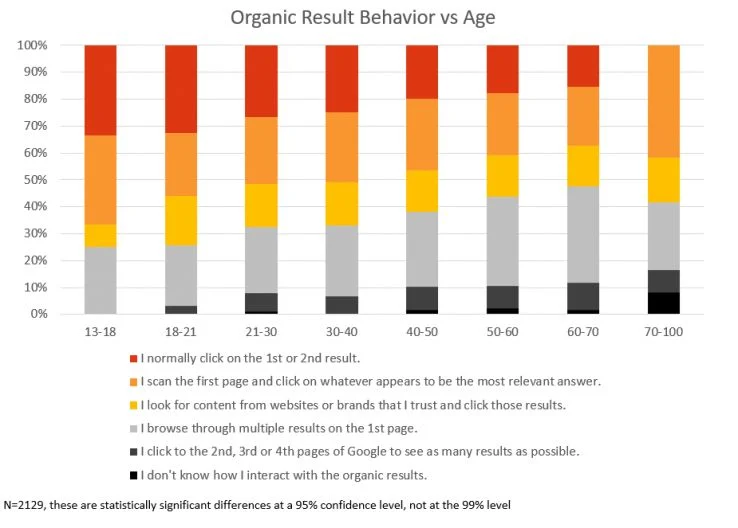Search engine optimisation (SEO is a huge part of digital marketing and crucial to making your business a success. SEO is the process of improving one’s website to increase its visibility on search engines, such as Google. By improving your SEO, your site will show up higher on relevant searches, catching the attention of more potential customers or clients.
By making your website more visible, you can boost the marketability of your brand or product. Recent research has shown that around 60% of shoppers research a brand online before buying from them, making a strong digital presence important.
Why is SEO important?
Having a good SEO strategy is one of the best ways to increase your organic reach, and improve the credibility and authority of your site. There are two main categories of traffic: organic and paid. While paid traffic usually comes from advertisements, sponsorships and placements to drive traffic, organic content refers to visitors who come to your website by clicking on unpaid search engine results.
Paid traffic comes as a result of a website’s advertisements being displayed on other websites or through sponsored search engine results. Various advertising platforms, such as Google Ads or Facebook Ads, help achieve this. Paid traffic has numerous advantages, driving instant traffic to a website, and garnering quick results. This can be especially helpful for businesses looking to promote a time-sensitive sale or the launch of a new product. However, paid traffic can be expensive, and it requires ongoing investment to maintain traffic levels over a longer period of time. Paid traffic is also considered to be less trustworthy than organic traffic as it isn’t ‘earned’, but rather paid for. This can be reflected in a site’s conversion rate, which will often be lower compared to organic traffic as visitors would not actively be looking for the website’s content.
On the other hand, organic traffic comes from good SEO, and is the result of a website being optimised to rank higher in search engine results. By delivering high-quality, original, optimised content on your website, your website is more likely to appear higher up in search results. Between 40-60% of people look no further than the first page of search results, and the top search result receives almost 30% of all clicks. People make over 8.5 billion searches in Google every day – that’s over 3 trillion a year! – making it essential to have an excellent SEO strategy. Unlike paid traffic, it’s free to maintain good SEO, and the website will therefore be of higher quality content as its search engine ranking is ‘earned’. Visitors to your site will arrive because they are genuinely interested in what your website has to offer, increasing your visibility, reputation and reach over time.

It’s important to know when to use paid and organic traffic. While organic traffic will help build the authority of a site, paid ads can often generate leads quickly and have immediate payoffs, therefore making it vital to use a combination of both. When considering whether to use organic or paid traffic, take into account the following points:
- How quickly you need results: Paid traffic can yield results in minutes, while organic traffic can take as long as years.
- Your budget: While paid traffic is costly, and can have a poor return on investment (ROI) over time, generating organic traffic is both time- and resource-intensive.
- Quality: Only 20-30% of searchers actually click on paid results, while 70-80% do for organic SEO. High quality content generates high quality traffic.
How does SEO work?
Keywords
SEO is commonly associated with keywords and phrases – the things that allow your website to show up when searched. Keywords help search engines understand the content of a certain website or page. By targeting certain keywords, businesses can optimise their sites to rank higher in search engine results.

While the natural inclination may be to use as many keywords as possible to show up in as many searches as you can, it’s also important to make sure you use the right keywords. Researching what search results correspond to keywords can help you ensure the keywords you use display relevant content in search results. Keyword research involves identifying the most relevant and high-traffic keywords that a website should target. Tools such as Google Keyword Planner, SEMrush, and Ahrefs can all help with targeting the right keywords.
While search engines place more value on keywords in a page’s title and the first paragraph of content, they also search for keywords in other parts of a webpage. These include a page’s URL, meta description, and image file names, amongst other things. You’ll want to make sure that these all include the main topic or keyword of the page to maximise keyword optimisation.
A page’s meta description doesn’t just influence SEO, but can attract visitors. Meta descriptions are often displayed as the snippet of text in search engine results, making a well-written description an attraction for searchers.
However, it is essential to use keywords in a natural and relevant manner to maintain high quality content. If not, you can run the risk of keyword stuffing, saturating your content with specific keywords. This can be detrimental to your SEO, as search engines will penalise tactics that are inorganic.
Microdata
As well as utilising a page’s meta description, SEO can be improved through microdata. Microdata is a data language that annotates HTML code to add further information and context about a website’s content. A type of microdata, schema markup, provides search engines with additional detail beyond the basic HTML tags, making it easier for search engines to understand the content and display it in more relevant search results.
By using schema markup, you can improve your website’s SEO, making it appear in more relevant searches. Schema markup allows you to add detail about your website such as the type of content, its author, the date it was published, and more. These details can then help a website stand out in search results and improve its click-through rate.
Hyperlinks
Another important aspect of SEO is hyperlinks. Using crawlers, search engines look at the content of a website page to create an index of all the webpages in the world. Search engines then rank the index it has created, based on each page’s SEO. Search engines can use different algorithms to rank websites; for example, Google uses Hummingbird, which trivialises keyword stuffing, instead encouraging the use of natural language without duplication, as well as hyperlinks.
For crawlers to be effective, pages need links to connect to other pages on the same site, or external links to different websites. By using hyperlinks, you can make your pages more easily discoverable by crawlers, therefore improving their chances of being included in a search engine’s database.
Inbound links to other websites, also known as backlinks, also help with a website’s visibility on search engines. The more backlinks that redirect people to your website, the more likely your site will rank high in search results (the authority, niche and quality of linking website play a role as well). Therefore, it’s helpful to earn backlinks, and in turn, give out some backlinks of your own.
However, not all backlinks are equal. Websites are assigned a domain authority value – the higher the value, the higher quality the page is considered. The quality of a website’s content, including its age, relevance to search engine results, as well as backlinks all make up a site’s domain authority. Backlinks from sites with a higher domain authority are considered more valuable by search engines. Quality control can affect SEO significantly, and pages with functional links, longer content and multimedia benefit from this.
Backlinks are not the only type of hyperlinks. Internal links are links within a website that direct visitors to other pages on the same website. This improves the user experience of visitors, making it easier for them to navigate the website, while also helping search engines understand the structure of the website and the relationship between its pages. Additionally, internal links help distribute access to pages equally across your website, which can boost the rankings of all pages on the site.
It’s important to ensure that hyperlinks remain up to date. Broken links can be detrimental to a website’s SEO, as it signals that a website has not been maintained and is out of date. By fixing broken links, companies can improve their website’s user experience and search engine rankings.
User experience
Finally, the user experience of a website is another major factor that SEO takes into consideration. Broken links are one example of poor user experience. Similarly, pages with duplicate content can be red flags for poorly maintained websites, confusing both search engines and visitors.
Mobile-friendliness is something that can also affect user experience – the majority of Google searches are now conducted through a mobile phone, with 63% of Google search traffic originating from mobiles. Furthermore, nearly 80% of people will stop engaging with websites that don’t display well on their device.
Since the end of 2017, Google has gradually been shifting to mobile-first indexing, meaning Google uses the mobile version of websites (rather than the desktop version) for ranking and indexing purposes. This is why it is essential that your website has the same experience across devices, including having the same content, headings, and data.
Search engines also take page speed into account, using the time it takes to load a page as a quality indicator. Faster load times improve user experience, and is a factor that search engines use to rank sites. Fortunately, both page speed and mobile-friendliness can be assessed: for example, Google provides mobile-friendliness and page speed tools. You can also find out more about how to improve a website’s speed here.
Other tools are also available to monitor aspects such as domain authority. By providing valuable and informative content, quality website navigation, and search result relevance, both the domain authority and overall user experience of the website will be improved.
By tracking user experience using certain metrics such as time spent by visitors on your page, the click-through rate of visitors (the percentage of visitors who click on your page out of all users who come across the link), and your bounce rate (the percentage of visitors who visit only one page on your site), you can understand more about the performance of your website. A higher time spent on page and click-through rate, and a lower bounce rate are good signs. Sites such as Google Analytics can help you check these statistics.
A different audience
It’s important to note that there is a lot more to SEO than outlined here. Elements such as location and search history all change an individual’s search results. For example, while ‘local SEO’ follows the same rules outlined above, it also considers location. Optimising your website for local SEO involves including your company’s name, address and phone number. By including these details, your website is more likely to show up when someone searches for a business nearby or in a specific location, though business reviews can also play a role in ranking and indexing.
Achievable goals
The final element of a good SEO strategy is to set SEO objectives. Setting SEO objectives helps provide direction and focus for your SEO efforts, quantify how well you’re doing, and prioritise tasks and allocate resources effectively.
Objectives that are measurable include use of keywords, incoming traffic, as well as your brand’s market share, reputation, and lead generation. However, different objectives work best for different kinds of businesses. Lead generation is more important for businesses working with clients, while focusing on website traffic is best suited for informational businesses.
How can we help?
SEO encompasses a wide range of practices and requires a data-heavy outlook on a variety of factors including user experience, content strategy, website wording, loading speed, website security and content formatting.
Having an excellent SEO strategy can help companies increase their traffic and reach, capture the attention of new audiences, particularly alongside corporate comms campaigns, as well as collect quantifiable data to determine strengths and improvements.
At Sapience, our SEO strategy has allowed us to successfully provide excellent results for high-profile clients including Huawei, Quickbooks, SAP and uSwitch.
If you’d like to find out more information on what SEO services we provide, contact us.
You may also be interested in our other resources & guides:
